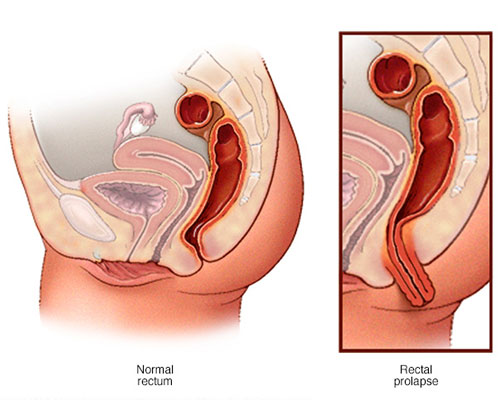Rectal Prolapse

What Is Rectal Prolapse?
Almost all cases require medical care, and in most cases, surgery is required to treat and cure the problem. Most cases will worsen without surgery. Occasionally, successful treatment of an underlying cause of a prolapsed rectum may resolve the problem. However, these scenarios usually involve infants or children.
The cause of this condition in many patients are constipation or straining while having a bowel movement.
Treatment
These tips may help ease bowel movements and ease symptoms.
- Try to avoid or reduce straining during a bowel movement. However, it may not be enough to correct the condition.
- Ease constipation and straining by eating plenty of fruits and vegetables and other fiber-filled foods, and drinking lots of water.
- Use stool softener if needed to help prevent straining during bowel movements.
- If a doctor has diagnosed you with the condition, and with his or her guidance you may be able to manually push the prolapse back into place. Check with your doctor about whether this is something you should do yourself, and how to do it effectively.
- For infants and children, reducing the need to strain during bowel movements with stool softeners may correct a prolapsed rectum.
- Women may find pelvic floor exercises (for example, Kegel exercises) can help improve symptoms.
- A doctor should always be consulted before any attempt to treat this condition at home.
What Is Rectal Prolapse Surgery?
The treatment goal of all of the surgical techniques used to correct a prolapsed rectum is to attach or secure the rectum to the back side (or posterior) part of the inner pelvis. Surgery is performed through either the abdomen or the perineum.
- Surgery through the abdomen
- Typically performed in younger or healthier patients
- Type of abdominal surgery usually determined by severity of associated constipation
- Associated with higher morbidity rate than perineal approach but lower recurrence rate of prolapse
- Performed under general anesthesia
- Usually involves a hospital stay of 3-7 days
- Perineal approach
- Typically performed in elderly people or people in poor health
- Approach for a patient who cannot tolerate general anesthesia
- Associated with higher recurrence rate than abdominal approach
- Usually involves a shorter hospital stay
